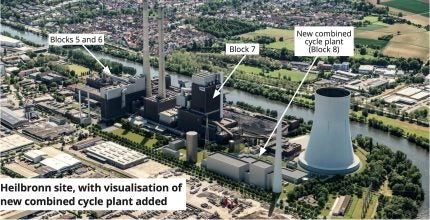
Work on parallel projects, in Stuttgart-Münster and Altbach/Deizisau, started last year. Overall, the three projects, totalling 1.5 GW and representing an investment of about 1.6 billion euros, will see the mid-Neckar region supplied with coal-free electricity and heat by 2026. EnBW says the new flexible and dispatchable capacity, installed alongside the ramp-up of renewables, will help “guarantee security of supply and grid stability in the region.”
With installed capacity of 710 MWe and around 190 MWt of heat, the new combined cycle power plant being built at Heilbronn will replace the coal-fired block 7 at the site. To secure the supply of district heating, a heat storage facility with a capacity of 600 MWh and a hot water boiler system with a district heating capacity of about 170 MWt are also being built. In the course of the fuel switch project, part of the district heating grid will also be modernised, improving energy efficiency by moving from a steam to a hot water network. The district heating grids supply around 300 industrial and commercial customers in Heilbronn and Neckarsulm, including Audi AG, alongside around 150 residential buildings.
The Heilbronn project is seen as an important milestone for EnBW’s goal of achieving climate neutrality as a company by 2035: Once commissioned, the new combined cycle plant will also be able to burn up to 20% hydrogen. The south German natural gas pipeline (SEL), which has been planned to be H2-ready, is set to connect the Heilbronn site upon completion. After the switchover and as soon as hydrogen is available in sufficient quantities, the Heilbronn power plant will be able to produce carbon-neutral electricity and district heating following minor conversion work. It will then play a key role in achieving the city of Heilbronn’s goal of becoming climate-neutral by 2035. The connection of the region to the hydrogen grid will also significantly help to keep the industrial location competitive.
In total, there are seven blocks on the Heilbronn site, three of which are still in operation. With an installed capacity of 1100 MWe/320 MWt, Block 7 is one of the largest hard coal units operated by EnBW. Extensively modernised once again in 2009, it currently guarantees a reliable supply of electricity and district heating in the Heilbronn area, says EnBW. The two older operable blocks, 5 and 6, are part of the grid reserve and are only used by the transmission system operator in the event of bottlenecks in the high-voltage grid. The Marbach and Walheim power plants are smaller sites linked to the Heilbronn site.
Block 7 will be shut down in parallel with commissioning of the new plant. The same also goes for blocks 5 and 6. The existing cooling tower, water intake and discharge structures belonging to block 7 will be used for the new combined cycle plant.
The fuel switch projects at Heilbronn and Altbach/Deizisau are being carried out by a consortium of GE Vernova , SENER and Bonatti. Each plant will employ a GE Vernova 9HA.01 gas turbine (the first to be installed in Germany), an STF-D650 steam turbine, a W88 generator, a triple pressure with reheat heat recovery steam generator and an integrated GE Vernova Mark* VIe distributed control system. The 9HA gas turbine is described as “hydrogen ready.”
The project at Stuttgart-Münster will see three coal boilers replaced by two 62 MWe Siemens Energy SGT-800 gas turbines with downstream heat recovery for district heating. Siemens Energy has provided assurances that “the new turbines will be able to process up to a 75 percent hydrogen admixture from the time they’re shipped, in 2024, and the overall package is prepared to handle 100 percent hydrogen.”
“We can’t yet reliably predict when green hydrogen will be available in sufficient quantity and at affordable prices,” says EnBW CEO Georg Stamatelopoulos, “but the technology should be in place by that time. We’re not going to put the cart before the horse. Which, by the way, is the objective in all our fuel switch projects.”


